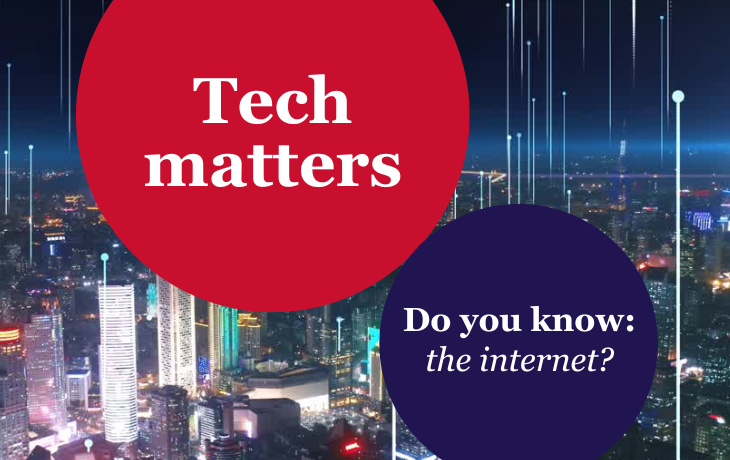The changes the internet could undergo over the next 10 years
Over the past 30 years, rapid advancements in technology have reshaped how we connect, communicate and consume information. The internet has evolved from slow dial-up connections to high-speed fibre networks, while cloud computing and mobile devices have made digital services more accessible than ever. We are now on the verge of a fundamental shift in how we interact with the internet – one that will be driven by artificial intelligence (AI), immersive technology and ever-present connectivity. This next phase will move us from a reactive to a proactive digital experience, where AI anticipates our needs before we even ask.
Laying the foundations (1995–2005)
In the decade from 1995, when the internet was fully commercialised, the foundations for today’s digital world were introduced. It was a key decade in the evolution of the internet across multiple dimensions:
- Access: the transition from dial-up to fixed broadband meant users were always online at faster speeds. Then came Wi-Fi, allowing users to unplug from home connections, while Bluetooth enabled short-range wireless connections. Around the same time, the first mobile broadband technology made internet access possible on the go.
- Intermediaries: the first content delivery network (CDN) was introduced, bringing content closer to users, while the first cloud computing service enabled remote access to software and computing power. These innovations helped to reduce the cost and improve the speed of online access to content and services.
- Content and services: Apple introduced iTunes, marking a shift towards digital distribution of music, and later video, by copyright holders. Next came user-generated content with YouTube, and the rise of social media, with Facebook’s launch.
- Devices: as personal computers were the main gateway to the internet, users wishing to go online were largely restricted to desktops and laptops. Feature phones and early smart devices enabled email and basic mobile services, but full access to emerging online content and services was still limited.
The rise of mobile and streaming (2005–2015)
The following decade built on these foundations, bringing higher speeds, new services, and mobile-first experiences.
- Fibre-to-the-home (FTTH) networks began rolling out, drastically increasing fixed-line internet speeds, while 4G LTE networks revolutionised mobile connectivity.
- Major tech companies launched their own CDNs to deliver content faster and began investing in submarine cables to support global distribution.
- Streaming services took off – Netflix introduced video streaming, while Spotify popularised music streaming.
- The most significant shift was mobile access, marked by the launch of the iPhone, the App Store and the iPad. Along with 4G, smartphones and apps replaced web browsers as the primary way people accessed the internet.
The foundations for a new internet (2015–2025)
Over the past decade, new technologies have set the stage for the next transformation in how we engage with the internet:
- 5G networks launched, increasing both speed and the ability to support Internet of Things (IoT) services such as smart city sensors.
- The first low-Earth orbit (LEO) satellite networks expanded global internet coverage, bringing high-speed connectivity to remote areas.
- New ways of interacting with the internet became mainstream – voice assistants and smart speakers allowed hands-free interaction, while virtual reality (VR) and augmented reality (AR) goggles popularised immersive experiences and the metaverse.
- The most significant shift was the introduction of ChatGPT in 2023, marking the rise of generative AI. AI-powered systems are now generating text, audio and video, transforming how people create digital content.
The next decade: AI, anticipation and continuous interaction
The next phase of the internet will no longer be just about access, it will be about how we interact with technology. Generative AI will be embedded in everyday life, accessible through 5G and satellite networks, and integrated into headsets, sunglasses, smart speakers, vehicles, robots and devices yet to be conceived.
The real transformation will be in how we engage online. Today, interaction on the internet is based on prompts – we type a request or wake up a smart speaker to ask a question. But in the future, AI will not wait for prompts. Instead, it will proactively learn our preferences, anticipate our needs and act on our behalf.
We will communicate naturally with AI, experience immersive environments, and live in a world where connectivity is seamless and ubiquitous. However, making this vision a reality will require:
- Trust and privacy protections – the more personal data we share, the greater the need for strong privacy, security and ethical safeguards.
- Sustainable infrastructure – new data centres, edge computing and submarine cables will be needed to support AI-driven services, and they should be built with energy efficiency in mind.
- Rethinking human–AI interaction – the internet will no longer be a tool we turn to, it will be an active participant in our daily lives. How we balance convenience, control and autonomy will define this next era.
Over the next decade, AI and immersive technology will transform how we live, work and interact with the world around us. Instead of simply searching for information, we will engage in intelligent conversations with AI assistants. Instead of navigating screens, we will experience digital content in 3D spaces such as glasses or headsets. Instead of waiting for answers, the internet will work seamlessly in the background, anticipating our needs and enhancing our daily experiences.
This is not just an evolution, it is the foundation for a more intuitive, personalised and connected digital future.

Do you know the internet?
Author

